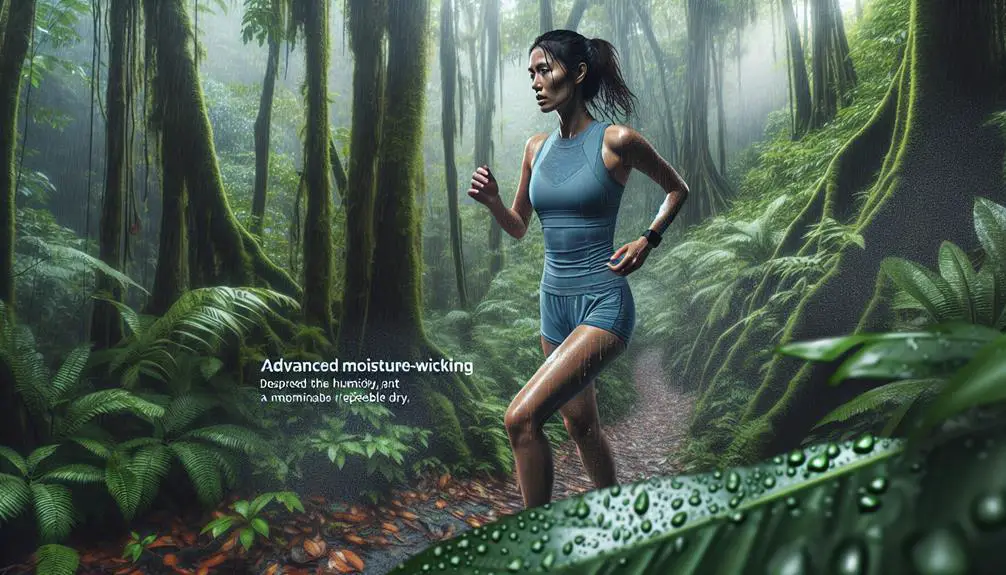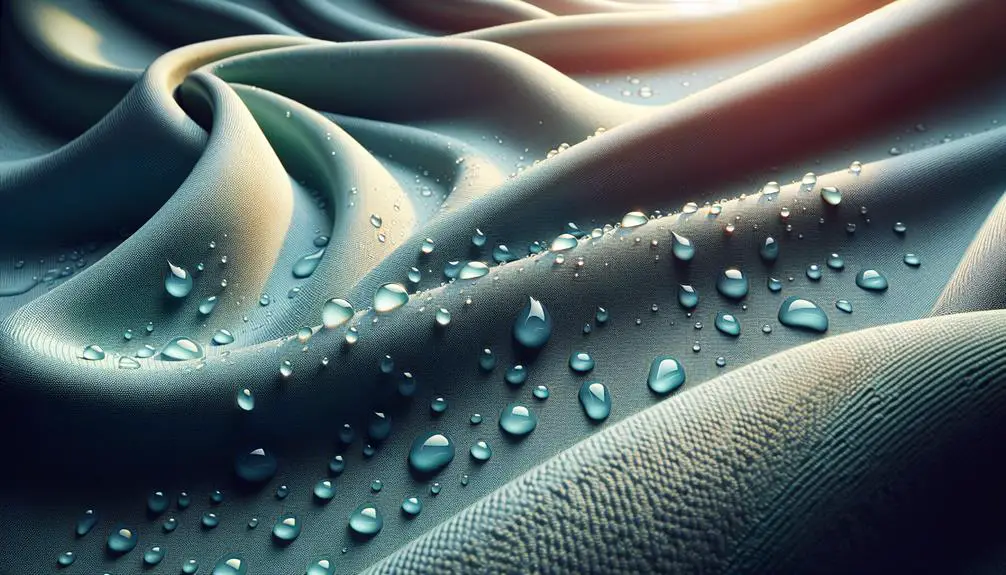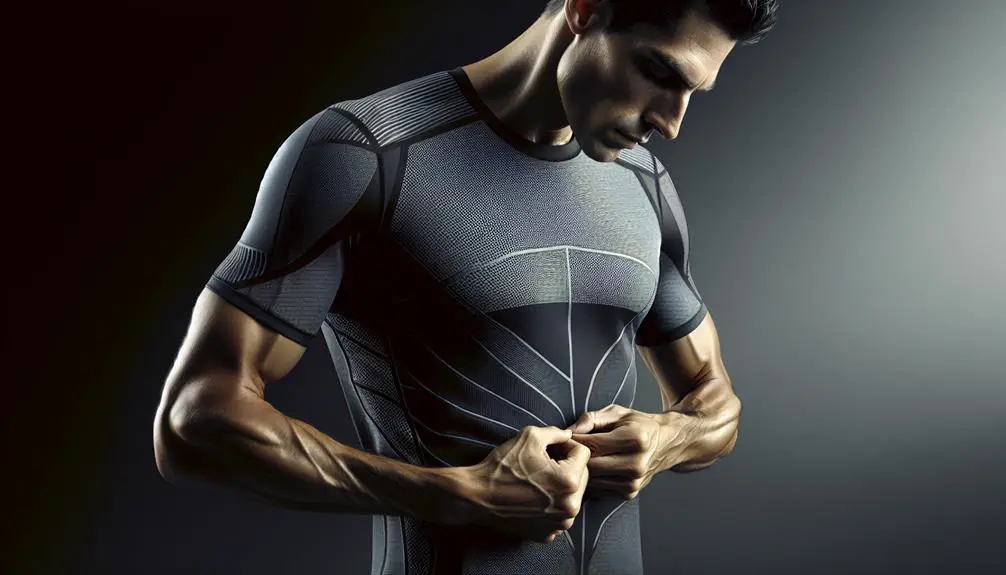Guarantee top-notch performance in humid climates by selecting moisture-wicking fabrics like polyester, nylon, or merino wool for effective sweat management. Choose snug fits that strike a balance between breathability and movement, enhancing moisture-wicking efficiency. Proper care involves washing with gentle detergent, air-drying thoroughly, and storing in a cool, dry place. Layering plays a crucial role – start with a moisture-wicking base, add breathable layers as needed, and include a waterproof outer layer for rain. Following these tips will help you stay dry and comfortable in humid conditions. Mastering these basics sets the foundation for peak performance.
Key Points
- Choose moisture-wicking fabrics like polyester, nylon, or merino wool.
- Ensure a proper fit for enhanced breathability and freedom of movement.
- Wash garments in cold water, avoid fabric softeners, and store properly.
- Layer with breathable materials like merino wool and adjust based on activity and weather.
- Opt for blends for improved performance and consider layering strategies for varying conditions.
Importance of Moisture-Wicking Fabrics
Understanding the role of moisture-wicking fabrics is essential in managing perspiration effectively in humid climates. These fabrics offer substantial benefits when it comes to comfort and performance in such conditions. One of the key advantages of moisture-wicking fabrics is their ability to transport sweat away from your skin to the outer surface of the fabric where it can evaporate quickly. This process helps in keeping you dry and comfortable during physical activities, preventing the sticky feeling often associated with sweating.
Moreover, the breathability of moisture-wicking fabrics is vital in humid climates. By allowing air to pass through the fabric easily, these materials enhance ventilation and help regulate your body temperature. This feature is particularly important when engaging in high-intensity exercises in hot and humid environments, as it can prevent overheating and improve overall performance. When selecting clothing for humid climates, prioritizing moisture-wicking fabrics can greatly enhance your comfort and ensure top performance levels.
Choosing the Right Material
To effectively select the right material for moisture-wicking clothing in humid climates, consider the specific properties and performance characteristics of various fabric options available.
When choosing moisture-wicking clothing, opt for breathable options like polyester, nylon, or merino wool. Polyester is a popular choice due to its ability to swiftly draw moisture away from the skin and allow for evaporation.
Nylon is another excellent option, known for its durability and quick-drying benefits, making it ideal for intense physical activities in humid conditions. Merino wool, although not as commonly used, offers natural moisture-wicking properties and is odor-resistant.
Additionally, consider blends of these materials for enhanced performance. These fabrics not only wick away sweat from your body but also allow for improved air circulation, keeping you cool and dry in humid climates.
Prioritizing breathable and quick-drying materials will guarantee your comfort and performance during strenuous activities in humid conditions.
Proper Fit for Enhanced Performance
For peak performance, make sure that the moisture-wicking apparel fits snugly but allows for freedom of movement during physical activities in humid climates. The essential fit of moisture-wicking clothing is vital for enhanced breathability and performance optimization. A snug fit guarantees that the fabric sits close to your skin, wicking moisture away efficiently. This close contact also promotes the transfer of sweat to the outer layers of the garment where it can evaporate more easily, enhancing breathability.
At the same time, it's important to verify that the clothing allows for freedom of movement. Restrictive apparel can hinder your performance during physical activities. Look for moisture-wicking clothing that features stretchable materials or design elements such as gussets to offer flexibility without compromising the moisture-wicking properties. This balance between a snug fit for moisture management and freedom of movement is key to optimizing your performance in humid climates.
Care and Maintenance Tips
Consider implementing a vital washing routine with specific detergents to maintain the peak performance of your moisture-wicking clothing in humid climates. Cleaning techniques play an essential role in preserving the moisture-wicking properties of your garments. Wash them in cold water to prevent damage to the fabric and always use a gentle detergent free from fabric softeners, as these can clog the fabric's pores and reduce its moisture-wicking capabilities. Avoid using bleach, as it can deteriorate the fibers and affect the garment's moisture-wicking efficiency over time.
When it comes to storage solutions, make sure your moisture-wicking clothing is completely dry before putting it away to prevent mold and mildew growth. Store them in a cool, dry place away from direct sunlight to maintain their integrity. Hanging them up instead of folding can also help retain their shape and prevent wrinkles. By following these cleaning techniques and storage solutions, you can prolong the lifespan and effectiveness of your moisture-wicking clothing in humid climates.
Layering Strategies for Humid Weather
Implementing effective layering strategies can optimize your comfort and performance in humid weather conditions. In such environments, managing sweat and ensuring proper airflow are essential for maintaining a comfortable body temperature. Here are some tips for layering in humid weather:
- Start with a Moisture-Wicking Base Layer: Choose a base layer that's designed to wick sweat away from your skin, keeping you dry and comfortable.
- Add Breathable Layers: Opt for breathable materials like merino wool or synthetic fabrics that allow air to circulate and prevent overheating.
- Consider a Lightweight Mid-Layer: A lightweight mid-layer can provide extra warmth without trapping excess heat, making it ideal for unpredictable weather conditions.
- Use a Waterproof Outer Layer: In case of rain or high humidity, having a waterproof outer layer will help repel moisture while still allowing sweat to evaporate.
- Adjust Layers as Needed: Be prepared to adjust your layers based on the intensity of your activity and the changing weather conditions to maintain the best comfort and performance.
Frequently Asked Questions
Can Moisture-Wicking Clothing Be Worn in All Types of Humid Climates, or Are There Specific Conditions Where It May Not Be as Effective?
In various humid climates, moisture-wicking clothing, with its advanced fabric technology, excels at managing perspiration by enhancing breathability and moisture control. However, specific conditions like extreme humidity or prolonged rainfall may challenge its effectiveness.
Are There Any Potential Drawbacks or Limitations to Using Moisture-Wicking Fabrics in Humid Environments?
In humid climates, potential limitations of moisture-wicking fabrics may arise due to inadequate fabric breathability. High humidity levels can challenge the effectiveness of these materials, reducing their ability to efficiently wick moisture away from your skin.
How Do I Know if a Garment Is Truly Moisture-Wicking, and What Should I Look for When Shopping for This Type of Clothing?
To determine genuine moisture-wicking fabric, scrutinize for high-grade fabric technology and reliable performance test results. Seek garments with exceptional moisture absorption and rapid drying capabilities. When shopping, prioritize these qualities for effective moisture management in humid conditions.
Are There Any Specific Activities or Sports Where Moisture-Wicking Clothing Is Particularly Beneficial in Humid Conditions?
During yoga, moisture-wicking clothing enhances comfort by managing sweat efficiently. For hiking, these fabrics help regulate body temperature, reducing chafing and the risk of overheating. Their impact on performance in hot weather is significant and beneficial for active individuals.
Can Moisture-Wicking Clothing Also Help With Odor Control in Addition to Managing Sweat in Humid Climates?
Yes, moisture-wicking clothing can help with odor control. The fabric technology used in these garments not only manages sweat but also inhibits odor-causing bacteria growth, keeping you fresh and comfortable in humid climates.



